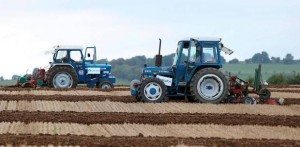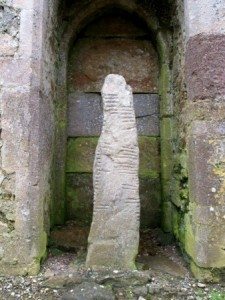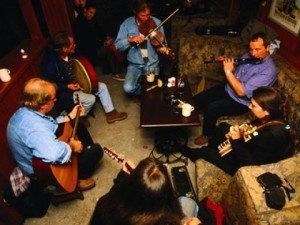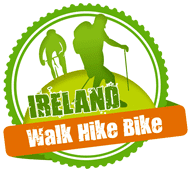Our guests fall in love with the simplicity and romance of traditional life in Ireland, sometimes before they have even arrived in the country! Traditional heritage in Ireland stems from the land and the sea and their influence on people’s lives and well-being. It is intrinsic in the lives of our ancestors and influential to many an artist or poet. The following are some of the activities that made up traditional Irish life and heritage, and their place in modern Ireland. Look out for their influence when you are on tour;
Boat Making
As an Island, fishing has long been a method of feeding the family and, particularly along the Atlantic coast, this has resulted in boat making developing into distinct styles. These are two classics;
The Currach; this rowing boat is the archetype of traditional Irish fishing for centuries. In fact, St. Brendan was said to have taken his epic voyage to America in a Currach during the 1st Century. There are variations of this rowing boat along the coast of Ireland linked strongly to the community the boat developed in. The type of Currach native to the Blasket Islands, the Naomhóg, of which there is a great example in the Blasket Island Heritage Centre is considered to be the Rolls Royce of Currachs. The influence of the Currach is still felt with these boats still being raced in regattas and races around the country check out this video to get a glimpse into the tradition;
The Galway Hooker, full size example of which is in the Galway City museum, is a more contemporary style of fishing boat dating from around the 18th Century. It is easily identified by the sail formation, which is extremely distinctive and quite beautiful. It consists of a single mast with a main sail and two foresails. Traditionally, it was used by the fishermen of the Claddagh to navigate the shallow waters of Galway bay. Examples of this boat have been spread far afield by Irish settlers, in Boston, USA Irish emigrants needing boats to fish so built the Galway Hookers they were familiar with from home, in time these became known as Boston Hookers or Paddy Boats.
The oldest intact Irish vessel is a huge logboat from Addergoole Bog, Lurgan, Co. Galway, hollowed out from the trunk of an oak tree around 2500 BC. This is housed in the National Museum of Ireland Archaeology in Dublin.
Cork Harbour Festival is worth a visit if you want to see examples of Irelands rowing boats race. To learn read more about traditional boats in Ireland read here.
Farming

Farming is still to this day a representation of traditional Irish life to which most Irish country people are connect to. Despite there being far less farmers now than in this past, the majority of people can trace their family back to a farm at some point in their lineage.
Muckross traditional farm in Kerry is a great way to step back in time and see how life on Irish farms in the 1930s worked the romance and simplicity of this era is seen through a tour of the school house, labours cottage and different family farms. Traditional Furniture and farm machinery can be seen along the tour and there is also a petting farm for younger visitors.
The National Ploughing Championships is a huge festival celebrating traditional Irish farming values and allowing the farmers of Ireland an excuse for a day out. Beginning in 1931, the championships started out as a way to settle an argument between two lifelong friends, Denis Allen of Gorey, County Wexford and JJ Bergin of Athy, County Kildare, as to which county had the best ploughmen. Now it is Europe’s largest outdoor exhibition and trade show, attracting over 279,000 attendees and 1400 exhibitors in 2014 alone.
Turf cutting and the bog
Turf or Peat is a fuel cut from the bogland/peatland that was traditionally used by Irish families to heat their homes and cook their food. The cutting and turning of the turf was usually an activity the whole family would be involved in, a painstaking process demonstrated in this video:
The Kerry Bog village is a great example of Irish life on a bog village during famine times in Ireland. Its located on vast Bog land. Visitors learn about the bog, its wildlife, and equipment used to extract the turf.
Since 1998 more and more restrictions on turf cutting have been put in place to help prevent the degradation of Irish Peatlands. The bog supports rare and threatened species and the ongoing degradation of Irish Peatlands is devastating to the biodiversity at regional, national and international level. It additionally has consequences for climate change as the natural Peatlands act as a long-term carbon store, actively removing carbon from the atmosphere, however, this is reversed when the Peatland is damaged and carbon is released into the atmosphere.
Ireland Walk Hike Bike proudly supports the Irish Peatland Conservation Council.
Irish Language and the Gaeltacht

Irish is one of the oldest and most historical written languages in the world. The earliest evidence of this is on Ogham stones from the 5th century. Irish and English are both official languages of the Republic of Ireland, English being most commonly spoken in daily life with the exception of the Gaeltacht regions of Ireland where Irish is the language spoken.
During the Tudor conquest of Ireland during the 16th century and subsequent wars, the English language was imposed on the Irish people and the Irish ruling class was abolished. The new ruling class, or Ascendancy, spoke English, and thereafter English was the sole language of government and public institutions.
Towards the end of the eighteenth century the Anglo-Irish Ascendancy had begun to develop an academic interest in the Irish language and its literature. In 1893 The Gaelic League was established, the objective of maintaining and extending the use of Irish as a vernacular. Since then Ireland has become an independent republic and various efforts have been put in place to keep this historic language alive.
Seachtain na Gaeilge (Irish Language Week) is an international Irish language festival and one of the biggest celebrations of our native language and culture that takes place each year in Ireland and in many other countries.
If you will be visiting a Gaeltacht region on your tour and you want to pick up a few words of Irish before you arrive in Ireland this is a great resource but don’t worry everyone in the Gaeltacht speaks English so you’d only be learning for fun! If you want a chance to hear spoken Irish on your tour but aren’t near a Gaeltacht there is an Irish radio station, RnaG (92 -94 FM) and television channel, TnaG which should be easy to access at your B&B or online.
Folk music and dance
 Ireland has a number of tradition instruments and dances and as with the majority of Irish heritage our folk music and dance has developed from a grassroots level. Although some instruments and dances, for example the Harp, can be found in our history over a thousand years ago the folk music and dance that we know today originated in dancehalls and pubs all over Ireland since the 19th Century. With Irish Dancing becoming so popular internationally in 1994 by the Riverdance show, our guests often wonder where they can see real folk music and dance.
Ireland has a number of tradition instruments and dances and as with the majority of Irish heritage our folk music and dance has developed from a grassroots level. Although some instruments and dances, for example the Harp, can be found in our history over a thousand years ago the folk music and dance that we know today originated in dancehalls and pubs all over Ireland since the 19th Century. With Irish Dancing becoming so popular internationally in 1994 by the Riverdance show, our guests often wonder where they can see real folk music and dance.
An Fleadh Ceol are annual festivals of Irish traditional music, dance, song and language run by Comhaltas Ceoltóirí Éireann (CCÉ), they are carried out all over the British Isles and in America. It incorporates all aspects of traditional Irish music, competition categories include a wide variety of instruments as well as categories of duets, céilí bands etc. Check out the Fleadh schedule here to see if there’ll be anything on near you.
Different styles of dance and music are associated with different people or parts of the country. Siamsa Tire, the National Folk Theatre, has been instrumental in preserving ‘Munnix’ style of dancing as taught by the travelling dance master, Jeremiah Molyneaux, or Jerry Munnix. They also have a festival of Song, Music and Dance from May to September which is well worth a visit.
Folklore and Story telling
The early High kings of Ireland had bards or poets who were expected to remember all relevant information up to that point in the clan’s existence. This is where Ireland’s myths and legends originate and the tradition of storytelling began. A lot of these stories have been passed down through generations orally before the written word was common place.
Oral tradition has a big part to play in traditional Ireland. Before the days of television and radio, storytelling was very important for the local community to pass news and stories along via word of mouth. This was especially true during a time when children left school early to work on the farm and illiteracy levels were high.
A seanchaí is a traditional Irish storyteller/historian and they are rare but still around Ireland today. Here’s two great examples of Seanchaís Eddie Lenihan and the late Eamon Kelly;
To find story telling events near you the story tellers of Ireland list the events they are involved in here. If you want to get the gift of the gab for yourself you could always kiss the blarney stone!
There’s loads of ways to see and experience aspects of Irish heritage while on your Irish tour as shown above. If you want a well-rounded glimpse into traditional Ireland and Irish Heritage the National Country Life Museum which houses the national folk life collections in Castlebar, Co. Mayo is definitely worth a visit. The museum also run a free festival called Féile na Tuaithe which is a two day family festival that celebrates all that’s good about country life and traditions of bygones days.
